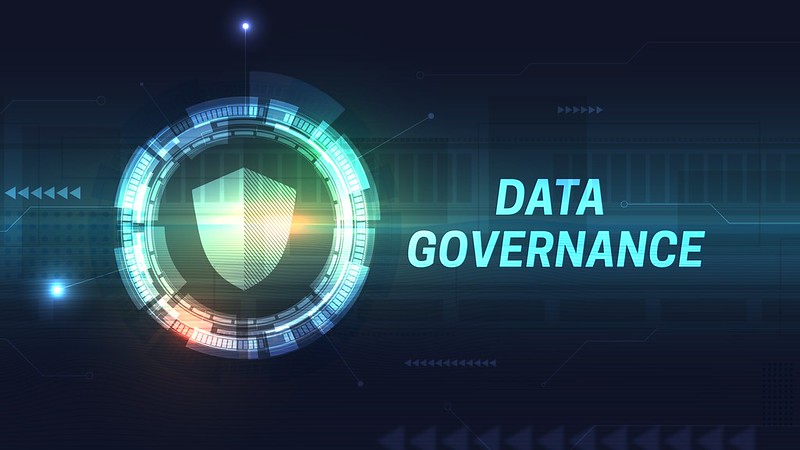
Navigating the Intersection: IT Governance, Data Governance, and the Evolving Role of DBAs
This post offers an exploration of the theoretical underpinnings and practical applications of IT and data governance. It examines governance frameworks, data management strategies, and database administration techniques within contemporary business contexts. The article presents actionable insights and recommendations for implementing robust IT and data governance practices across diverse organizational landscapes. Emphasis is placed on enhancing data security, ensuring compliance, and aligning governance strategies with strategic objectives.
Introduction
In today’s digital age, effective IT and data governance are imperative for organizations to navigate the complexities of technological advancements, data proliferation, and regulatory requirements. Recent statistics underscore the significance of these governance frameworks and shed light on emerging trends in the realm of database administration.
Rationale
According to a survey conducted by Gartner, by 2023, 60% of organizations will formalize IT governance mechanisms to manage digital transformation initiatives effectively. This highlights the growing recognition of IT governance as a critical component in driving organizational agility, innovation, and risk management strategies.
Furthermore, the exponential growth of data has propelled the importance of data governance to the forefront of organizational priorities. A study by Forrester Consulting revealed that 74% of global data and analytics decision-makers consider improving data governance as a top priority. As organizations increasingly rely on data-driven insights to inform decision-making, the need for robust data governance practices becomes paramount to ensure data quality, integrity, and compliance.
Amidst these developments, the role of database administrators (DBAs) remains pivotal in ensuring the efficiency and security of organizational data infrastructure. Recent statistics indicate a surge in demand for DBA expertise, with LinkedIn Workforce Report highlighting a 20% year-over-year increase in DBA job postings.
However, this demand is coupled with evolving job requirements, as organizations seek DBAs proficient in managing diverse database management systems (DBMS) and adept at implementing advanced security measures to safeguard sensitive data assets.
Against this backdrop, this article delves into the theoretical foundations and practical applications of IT and data governance, providing insights and recommendations to empower organizations in navigating the complexities of digital transformation and data management. Through an exploration of governance frameworks, data management strategies, and database administration best practices, organizations can fortify their governance initiatives and harness the power of data to drive innovation and strategic growth.
IT Governance
IT governance refers to a specific area of organizational management that concentrates on overseeing the IT function. Its responsibilities encompass the administration and implementation of the IT strategy, projects, and system operations within an organization. The methodology of IT governance varies across organizations based on their unique traits and requirements (Borja et al., 2018). In today’s business landscape, IT holds significant sway in terms of costs and strategic decision-making across nearly every industry. Therefore, IT governance assumes the responsibility for decision-making and strategic rights, along with associated accountability responsibilities (Gregory et al., 2018). Effective IT governance positively impacts product and process innovation (Borja, et al., 2018). Traditionally, the IT governance model revolves around steering and control, where steering provides direction and control ensures adherence to rules (Ajis & Baharin, 2019). The relationship and the hierarchy in the overall governance and management structure is depicted in Figure 1.
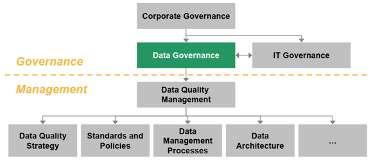
Data Governance
Data governance, a subset of IT governance, focuses specifically on managing organizational data. Through defined procedures, this governing body oversees the availability, usability, integrity, and security of data, thereby ensuring data quality management within the organization (Wende, 2007). The data governance body oversees data quality and access across decision-making, implementation, operational, and support phases, with support from top-level management. While the International guide to data management body of knowledge (DMOK) proposes a structured data management organization as per figure 2 (Saputra et al., 2018), smaller companies need to adapt such models according to their resources and requirements, maintaining clear competencies in steering and control for data governance.
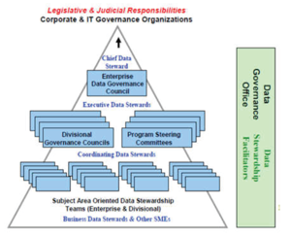
The adoption of data governance within an organization can be assessed using qualitative and quantitative metrics, as outlined by the Stanford data governance capability maturity model in figure 3 (Saputra et al., 2018). Such assessments help identify areas for improvement and resource requirements to enhance data governance practices.
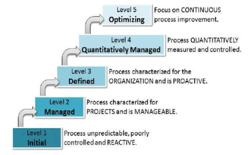
From the literature review, it is evident that both IT and data governance models share common purposes, emphasizing ownership, accountability, standardization, and documentation. While IT governance involves different committees and frameworks to direct strategy and control rules, data governance focuses solely on the data domain within the processes established in IT governance frameworks.
The role of the Database Administrator in the data governance architecture
Database administrators play a critical role in data governance, particularly in organizations utilizing relational database management systems (RDBMS) like Oracle, IBM DB2, Microsoft SQL Server, MySQL, and PostGres (Moore, 2010). They are responsible for maintaining data integrity and security, implementing access controls, and managing database performance and availability (Brant, 2011). Due to the sensitive nature of their work, DBAs enforce security controls and provide necessary reports to internal and external auditors regarding access and audit logs (Kumar & Hasani, 2016). Utilizing the data governance model proposed by Wende (2007) within an SME context (a company employing less than 200 employees), the Technical Data Steward role would be occupied by the Database Administrator (DBA), as per figure 4.
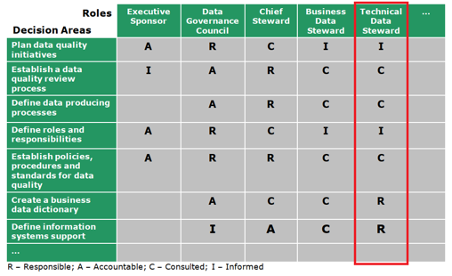
Organizations may choose to outsource certain IT administration tasks, including DBA responsibilities, based on factors such as expertise, availability, costs, and confidentiality (Beulen, 2015). The role of the database administrator is pivotal in data-driven organizations relying on RDBMS solutions, and their responsibilities continue to evolve alongside advancements in data governance (Brant, 2011).
Recommendations for action
The following recommendations serve as a general guide towards aligning the role of the DBA within the data governance framework and the overarching IT governance architecture.
- Assessment and Alignment:
- Conduct a comprehensive assessment of your organization’s IT governance framework to ensure alignment with strategic objectives and industry best practices.
- Regularly review and update IT governance policies and procedures to accommodate changes in technology, business requirements, and regulatory landscape.
- Data Governance Implementation:
- Establish a dedicated data governance body within your organization to oversee data management practices, including data quality, security, and compliance.
- Define clear roles and responsibilities for data stewards, data custodians, and other stakeholders involved in data governance processes.
- Develop and implement data governance policies, standards, and procedures to ensure consistent and effective management of data assets across the organization.
- Maturity Model Adoption:
- Utilize maturity models such as the Stanford data governance capability maturity model to assess the maturity level of your data governance practices.
- Identify areas for improvement and prioritize initiatives to enhance data governance maturity, such as establishing data governance metrics, implementing data quality controls, and enhancing data security measures.
- Database Administration Best Practices:
- Invest in training and development programs for database administrators to ensure they possess the necessary skills and expertise to effectively manage database systems.
- Implement robust security controls and access management policies to safeguard sensitive data stored in databases against unauthorized access and data breaches.
- Regularly monitor and audit database activities to identify security vulnerabilities, performance bottlenecks, and compliance gaps.
- Outsourcing Considerations:
- Evaluate the pros and cons of outsourcing certain IT administration tasks, including database administration, based on factors such as cost-effectiveness, expertise availability, and confidentiality requirements.
- Conduct due diligence when selecting outsourcing partners and establish clear service level agreements (SLAs) to define expectations, responsibilities, and performance metrics.
By implementing these recommendations, organizations can enhance their IT governance and data governance practices, mitigate risks, and optimize the value of their data assets in support of business objectives and regulatory compliance. Continuous monitoring, evaluation, and improvement are essential for maintaining alignment with evolving business needs and technological advancements in the dynamic digital landscape.
References
Ajis, A. F. M., & Baharin, S. H. (2019). Dark Data Management as frontier of Information Governance. 2019 IEEE 9th Symposium on Computer Applications & Industrial Electronics (ISCAIE). https://doi.org/10.1109/iscaie.2019.8743915
Beulen, E. (2015). Governance in IT Outsourcing Partnerships. Strategies for Information Technology Governance, 310–342. https://doi.org/10.4018/978-1-59140-140-7.ch012
Brant, I. (2011). Data Governance and the DBA. IBM Data Management. Retrieved from https://www.ibmbigdatahub.com/blog/data-governance-and-dba
Brock, J. D. (2015). Being the DBA (database administrator) nifty assignment. Journal of Computing Sciences in Colleges, 31(2), 275-277.
Borja, S., Kim, K., Yoon, H., & Hwang, J. (2018). IT Governance Effectiveness and Its Influence on Innovation Product and Process. 2018 Portland International Conference on Management of Engineering and Technology (PICMET). https://doi.org/10.23919/picmet.2018.8481752
Gregory, R. W., Kaganer, E., Henfridsson, O., & Ruch, T. J. (2018). It Consumerization and the Transformation of It Governance. MIS Quarterly, 42(4), 1225. https://dl.acm.org/doi/10.25300/MISQ/2018/13703
Kumar, B., & Hasani, M. H. S. A. (2016). Database security — Risks and control methods. 2016 First IEEE International Conference on Computer Communication and the Internet (ICCCI). https://doi.org/10.1109/cci.2016.777893
Monjaras, A., Bcndezu, E., & Raymundo, C. (2019). Decision Tree Model to Support the Successful Selection of a Database Engine for Novice Database Administrators. 2019 8th International Conference on Industrial Technology and Management (ICITM). https://doi.org/10.1109/icitm.2019.8710696
Moore, P. (2010). Database Administrator. Tech Directions, 70(2), 24–25. Retrieved from https://search-ebscohost-com.ezp.waldenulibrary.org/login.aspx?direct=true&db=eric&AN=EJ916638&site=eds-live&scope=site
Saputra, D. A., Handika, D., & Ruldeviyani, Y. (2018). Data Governance Maturity Model (DGM2) Assessment in Organization Transformation of Digital Telecommunication Company: Case Study of PT Telekomunikasi Indonesia. 2018 International Conference on Advanced Computer Science and Information Systems (ICACSIS). https://doi.org/10.1109/icacsis.2018.8618255
Tse, D., Chow, C.-K., Ly, T.-P., Tong, C.-Y., & Tam, K.-W. (2018). The Challenges of Big Data Governance in Healthcare. 2018 17th IEEE International Conference On Trust, Security And Privacy In Computing And Communications/ 12th IEEE International Conference On Big Data Science And Engineering (TrustCom/BigDataSE). https://doi.org/10.1109/trustcom/bigdatase.2018.00240
Wende, K. (2007). A model for data governance-Organising accountabilities for data quality management. ACIS 2007 Proceedings, 80.